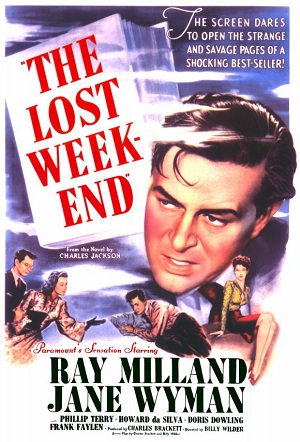 I fully realize that my last post was a review of a mid-80’s Italian Horror flick about a demon epidemic that takes over a small movie theater and later THE WORLD, so perhaps it’s super strange that I jump back and forth between black-and-white Best Pictures from the 1940’s and…well, that. But I’m going to do it anyways because I am a lover of all moviefilms. Viva movies! Though I do wonder how many members of The Academy have seen Demons. I’m guessing slim-to-none.
I fully realize that my last post was a review of a mid-80’s Italian Horror flick about a demon epidemic that takes over a small movie theater and later THE WORLD, so perhaps it’s super strange that I jump back and forth between black-and-white Best Pictures from the 1940’s and…well, that. But I’m going to do it anyways because I am a lover of all moviefilms. Viva movies! Though I do wonder how many members of The Academy have seen Demons. I’m guessing slim-to-none.
This Best Picture from 1945 recounts the life of an alcoholic New York writer, Don Birnam, as he attempts to give up drinking…but instead rages on a weekend alcoholic binge despite the good intentions of his brother and girlfriend. The movie, directed by Billy Wilder and starring Ray Milland and Jane Wyman, was based on a book of the same name written by Charles R. Jackson.
The movie starts with Don pretending to pack for a weekend trip with his brother. Rather than making sure he has his cell phone charger and iPad (or whatever was the 40’s version of those were), his brain is completely focusing on the bottle he has tied to his window sill, hanging outside over the window’s edge. (OK, if I was going to hide a bottle, that’d probably be the last place I would put it. I would take an Iced Tea container, dump out the tea, and put Jack Daniels in it. Then just put it in the fridge. I probably wouldn’t tie the JD to a rope and hang it outside. Probably would not. Just don’t offer your guests “Iced Tea.”)
Don dodges his brother and gal pal by sending them off to a show, leaving him alone just long enough to start his weekend bender. We see how others react to him, specifically a bartender at a local watering hole. Basically everyone thinks he’s Andy Dick. But what’s amusing about this film, from a modern perspective, is how literal Don is with his words…and how introspective:
“It shrinks my liver, doesn’t it, Nat? It pickles my kidneys, yeah. But what it does to the mind? It tosses the sandbags overboard so the balloon can soar. Suddenly I’m above the ordinary. I’m competent. I’m walking a tightrope over Niagara Falls. I’m one of the great ones. I’m Michaelangelo, molding the beard of Moses. I’m Van Gogh painting pure sunlight. I’m Horowitz, playing the Emperor Concerto. I’m John Barrymore before movies got him by the throat. I’m Jesse James and his two brothers, all three of them. I’m W. Shakespeare. And out there it’s not Third Avenue any longer, it’s the Nile. Nat, it’s the Nile and down it moves the barge of Cleopatra.”
I can assure you that I don’t speak as…uhh…”competently” as Don does when I’m hammered.
Even Don’s “hallucinations” are literal and old school – they certainly don’t mirror anything we’ve seen in Requiem for a Dream, that’s for damn sure. Once again, this film quest is kind of like seeing the world through a 1940’s kaleidoscope, both in terms of viewing society and its characters, but also in terms of filmmaking and filmmakers of the time. Even though at times Don and his problem were somewhat humorous because of the unrealistic dialogue (again, by today’s standards) and techniques, The Lost Weekend still gave us a great character to sink our teeth into, and an even better performance by Milland.
Grade: A-
The film is a short 99 minutes, so if you’re looking for an easily digestible classic to peruse, The Lost Weekend is a great place to start.
I have 30 Best Pictures left! Baby-stepping it to the 20s…


